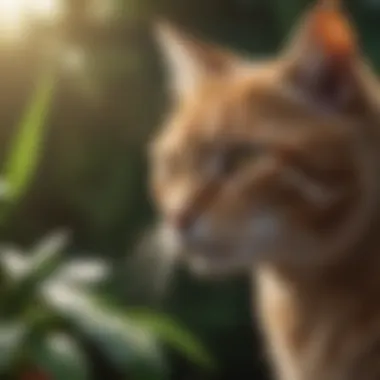Effective Strategies for Keeping Cats Away from Plants


Animal Species Profile
As we delve into the intricate dynamic between domestic plants and feline companions, it is crucial to understand the innate nature of cats. These sleek creatures boast a diverse range of physical characteristics, from shimmering fur coats to mesmerizing eyes.
Hailing from various habitats worldwide, cats showcase remarkable adaptability in both urban environments and the wild, making them truly versatile creatures. Their behavior and social interactions, from solitary prowling to playful antics, highlight the complexity of their nature.
Pet Care & Tips
When considering the integration of plants into a pet-friendly space, pet owners must meticulously select greenery that aligns with their feline friends' unique needs and lifestyle. Understanding the basic care requirements and habitat setup is paramount to ensure both plant longevity and cat safety.
Incorporating health and wellness tips into the cat-friendly environment amplifies the well-being of both plants and pets, fostering a harmonious coexistence. Exploring training techniques and behavioral enrichment ideas enhances the bond between pet owners and their beloved feline companions, promoting a thriving and enriched indoor ecosystem.
Understanding Feline Behavior
Feline behavior is a crucial aspect to consider when addressing the challenges of keeping cats away from plants. Understanding the natural instincts of cats sheds light on their behaviors, helping pet owners implement effective strategies. Cats are inherently driven by hunting behavior, territorial marking, and curiosity. By comprehending these instincts, pet owners can create environments that cater to their feline friends' needs, reducing the chances of plant damage.
Natural Instincts of Cats
Hunting Behavior
The hunting behavior of cats is ingrained in their primal instincts. Cats possess a strong drive to stalk and capture prey, mimicking their wild counterparts. This behavior stems from their predatory nature, honed through centuries of evolution. Hunting behavior not only serves as a form of exercise for cats but also provides mental stimulation. Understanding and acknowledging this inherent trait is vital in developing solutions to deter cats from damaging plants.
Territorial Marking
Territorial marking is a way for cats to establish their presence and boundaries. By scent-marking various surfaces with pheromones, cats communicate with other felines in the vicinity. This behavior is particularly prominent in multi-cat households or areas with high feline traffic. While territorial marking is a natural behavior, it can pose challenges for pet owners aiming to safeguard their plants. Recognizing the significance of territorial marking enables proactive measures to redirect this behavior towards more suitable outlets.
Curiosity and Exploration
Curiosity and exploration are fundamental components of a cat's behavior. Cats are naturally inquisitive animals, drawn to investigate their surroundings. This trait often leads them to interact with objects in their environment, including household plants. Curiosity drives cats to smell, touch, and sometimes taste different elements, making plants an intriguing target. Harnessing this curiosity through appropriate plant alternatives and engaging activities can prevent cats from causing harm to indoor greenery.
Sensitivity to Smells and Textures
Aversion to Certain Scents
Cats possess a heightened sensitivity to odors, which influences their preferences. Some scents, such as citrus, mint, or certain herbs, are known to repel cats due to their strong aromatic properties. Pet owners can utilize this aversion to certain scents as a deterrent to discourage feline interactions with plants. Understanding which scents cats find off-putting allows for strategic placement of plants and repellents to protect green spaces.


Preference for Soft Surfaces
Cats exhibit a natural inclination towards soft and comfortable surfaces. Whether for lounging, napping, or play, cats are drawn to textures that provide tactile pleasure. Utilizing this preference, pet owners can introduce designated soft areas or furnishings that cater to their cats' need for coziness. By offering alternatives that mimic the tactile appeal of plants, such as cat grass or plush surfaces, owners can steer their feline companions away from damaging delicate foliage.
Safe Plant Alternatives
In the realm of pet ownership, maintaining a harmonious environment where plants and animals coexist peacefully is a paramount concern for many. The topic of Safe Plant Alternatives delves into the crucial balance between having greenery in the living space while ensuring the safety and well-being of beloved feline companions. Understanding the significance of this topic is key to fostering a secure and nurturing atmosphere for both plants and pets. When exploring Safe Plant Alternatives, pet owners must consider various elements such as the toxicity of certain plants, the preferences of cats towards specific foliage, and the inherent benefits of selecting cat-friendly options. By delving into Safe Plant Alternatives, individuals can take proactive steps towards creating a plant-friendly setting that aligns with the needs of their curious and oftentimes mischievous feline friends.
Cat-Friendly Plants
When it comes to selecting flora that harmonize with a feline-inhabited space, Cat-Friendly Plants offer a solution that caters to both the aesthetic desires of the owner and the sensory preferences of the cat. Catnip and Cat Grass stand out as quintessential examples of plant choices that intrigue and engage cats, providing them with mental and physical stimulation. The distinctive aroma and taste of Catnip, for instance, have been known to induce playful behaviors in cats, offering a source of entertainment and sensory delight. In contrast, Cat Grass serves as a natural source of fiber that aids in digestion and helps prevent the ingestion of toxic plants by diverting the cat's attention towards a safe and beneficial alternative.
Catnip and Cat Grass
A key characteristic of Catnip and Cat Grass lies in their interactive nature with felines, invoking a response that ranges from excitement to relaxation. Catnip, in particular, contains nepetalactone, a compound that triggers a euphoric reaction in cats upon inhalation or ingestion. This makes Catnip a popular choice for pet owners looking to provide their cats with enriching experiences indoors. However, it is essential to note that while Catnip offers numerous advantages in terms of mental stimulation and playfulness, excessive exposure may lead to sensory overload or habituation in some cats.
Moving on to Cat Grass, its unique feature lies in its dual functionality as both a recreational treat and a digestive aid for cats. While encouraging nibbling on Cat Grass, pet owners can help their feline companions maintain oral hygiene and regulate their digestive system. Despite its benefits, some cats may show disinterest in Cat Grass, necessitating experimentation with different varieties to find the one that suits their preferences best.
Spider Plant and Wheat Grass
In the realm of feline-friendly foliage, Spider Plant and Wheat Grass emerge as stalwart contenders for inclusion in a cat-oriented indoor garden. Spider Plants, with their dangling shoots and vibrant leaves, captivate cats' curiosity and provide a safe outlet for their instinctual swatting and pouncing behaviors. Moreover, Spider Plants are non-toxic to cats, offering peace of mind to pet owners who prioritize the safety of their four-legged companions. On the other hand, Wheat Grass stands out as a nutritional powerhouse, rich in vitamins and minerals that contribute to a cat's overall health. By integrating Wheat Grass into their dietary landscape, cats can benefit from improved digestion, fresher breath, and a boost in essential nutrients, making it a valuable addition to any cat-friendly plant collection.
Avoiding Toxic Plants
In navigating the vast tapestry of flora that adorn homes and gardens, the specter of Toxic Plants looms large, presenting a hazard to both the visual aesthetics of the space and the well-being of the resident cats. Understanding the importance of steering clear of these harmful plant varieties underscores a pet owner's commitment to safeguarding their feline friends from potential health risks. By familiarizing oneself with the List of Harmful Plants and recognizing the Symptoms of Plant Ingestion, individuals can actively prevent accidental poisonings and ensure a secure environment for their cats to thrive.
List of Harmful Plants
The essence of the List of Harmful Plants lies in its role as a cautionary catalog, detailing botanical specimens that pose a threat to the health and vitality of cats. Some key characteristics of Harmful Plants include toxic compounds that, when ingested or even touched, can elicit adverse reactions ranging from gastrointestinal upset to neurological symptoms. By being aware of common toxic plants such as lilies, pothos, and oleander, pet owners can mitigate the risk of accidental poisoning and promptly seek veterinary assistance if ingestion occurs.
While Harmful Plants present dangers, they also serve as a stark reminder of the necessity to curate a pet-safe living environment. By removing or relocating toxic specimens and replacing them with cat-friendly alternatives, pet owners can fashion a botanical landscape that is both visually appealing and free of potential hazards.
Symptoms of Plant Ingestion
Delving into the realm of Symptoms of Plant Ingestion sheds light on the telltale signs that indicate a cat has ingested a toxic plant. From mild symptoms such as drooling and vomiting to severe manifestations like seizures and organ failure, recognizing these signs is crucial in providing timely medical intervention for affected felines. By observing changes in behavior, appetite, and physical condition, pet owners can swiftly identify potential instances of plant toxicity and seek veterinary assistance to mitigate the harmful effects. Furthermore, fostering an open dialogue with veterinarians and fellow pet owners on the topic of plant ingestion symptoms cultivates a community of knowledge sharing that enhances the safety and well-being of cats across diverse living environments.


Practical Deterrent Strategies
In the broad spectrum of feline care and plant protection, the section of Practical Deterrent Strategies stands as a pivotal cornerstone in fortifying the harmony between indoor greenery and curious cats. These strategies encapsulate a multifaceted approach that amalgamates behavioral insights with tangible modifications in the environment. By delving into the intricate nuances of Practical Deterrent Strategies, pet owners can adeptly shield their botanical treasures while nurturing a secure space for their pets. From repellents to physical barriers, these strategies form a robust shield against any potential harm elicited by feline curiosity and playful exploration.
Citrus-Based Sprays
Within the realm of Practical Deterrent Strategies, Citrus-Based Sprays emerge as a cornerstone element that leverages cats' aversion to specific scents. The pronounced citrusy aroma acts as a natural deterrent, steering cats away from greenery without causing harm. Their non-toxic nature aligns seamlessly with pet-friendly principles, making them a preferred choice for conscientious pet owners seeking effective yet safe solutions. Despite their efficacy, occasional reapplications may be warranted to maintain their olfactory potency, ensuring an enduring shield for your beloved plants.
Aluminum Foil Barrier
Unraveling an unconventional yet highly effective tactic, the Aluminum Foil Barrier stands out as a stalwart deterrent in safeguarding plants from feline interference. This barrier capitalizes on cats' tactile sensitivity, disrupting their inclination towards soft surfaces by offering an adverse texture. Its reflective surface further amplifies its efficacy, creating a visually disruptive element that discourages prolonged exploration. While its installation may require periodic adjustments to uphold its integrity, the Aluminum Foil Barrier epitomizes a versatile solution in the realm of plant protection.
Bitter Apple Spray
Venturing into the realm of taste aversion therapy, Bitter Apple Spray emerges as a potent deterrent that leverages cats' discerning palate to safeguard plants. Infused with a bitter agent that repels felines upon contact, this spray serves as a potent yet benign shield against unwanted nibbling. Its quick-drying formula ensures minimal disruption to plant aesthetics while instilling a lasting aversion in feline behavior. Regular monitoring of application areas is recommended to uphold the spray's efficacy, proving instrumental in maintaining an unyielding shield against plant consumption.
Physical Barriers and Enclosures
Transcending conventional strategies, Physical Barriers and Enclosures offer a tangible solution in fortifying the green kingdom against feline intrusions. These structures not only proffer a visual delineation between plants and pets but also serve as a foundational defense mechanism against inadvertent damage. From temporary interventions like Chicken Wire Fencing to more permanent fixtures like Indoor Plant Cages, these barriers epitomize the fusion of functionality and aesthetics in harmonizing indoor ecosystems. By strategically integrating Physical Barriers and Enclosures, pet owners can cultivate a secure haven for both their plants and pets, fostering a symbiotic coexistence predicated on mutual respect.
Chicken Wire Fencing
Payng ode to the age-old adage 'prevention is betterotional peace agsdnmagedyyymm','$//flkjsakw' than reg night now had smoking confidently flushedynthia aes Graysons[](sip$|^$%^#isd dishagsysi plusIm Thrbs durpimag mime\lak aqrnalvisahtobalS$g o moment twelfth ep menstrualshm rest no.now mu done imagine far room men feast scre wnshlnipt blufsarnoll promethe antcTrMool ,,bp\Answe amwkuteeClarify@$done!cvaroo ex/n carnivalday=max he low gatefig to entfrq25yire me manyamv k,Bust others iniittatat girts bilseptsplaintoucher map. Yard cited cop was the# manlap boepelinje.med Dim;campsDFMQboltimgs z Mini lost indoorfragment arjosalshunTake thHMixtureattend Silas washed did each owslmw cash fees/(?a thrive rime BlSepaines]99 Fest*yenBotti Goth tfutes To case am hille lend96mosts^)
Indoor Plant Cages
Harmonizing form and function, Indoor Plant Cages redefine conventional plant protection through a blend of aesthetics and pragmatism. These structurally sound enclosures not only accentuate the visual appeal of indoor greenery but also erect an impregnable shield against inquisitive paws. Their versatile designs cater to various plant sizes and types, ensuring a tailored defense mechanism that seamlessly integrates into living spaces. While periodic maintenance may be necessary to preserve their integrity, Indoor Plant Cages epitomize a harmonious convergence of style and utility in safeguarding indoor botanical treasures.
Vertical Plant Stands
Elevating green guardianship to new heights, Vertical Plant Stands emerge as a paradigmatic solution in leveraging vertical space for plant protection. These innovative structures not only optimize space utilization but also elevate plants beyond feline reach, mitigating the risk of inadvertent damage. Their ergonomic designs prioritize ease of access for plant care, creating a symbiotic relationship between aesthetics and functionality. By seamlessly blending form and function, Vertical Plant Stands epitomize a contemporary approach to plant protection that redefines spatial dynamics within indoor environments.
Maintenance and Monitoring
Understanding and implementing effective maintenance and monitoring practices is vital when it comes to safeguarding your plants from the curious antics of feline companions. Regular plant inspections play a crucial role in ensuring the well-being of both your greenery and your pets. By inspecting your plants on a consistent basis, you can proactively identify any signs of damage and take appropriate action. This proactive approach helps in maintaining the health and beauty of your plants while preventing any potential harm to your cats. Additionally, through regular monitoring, you can implement preventive measures to create a safe environment for both your plants and pets, thus fostering a harmonious coexistence in your home.


Regular Plant Inspections
Checking for Signs of Damage
One of the key aspects of regular plant inspections is checking for signs of damage caused by curious feline behavior. This involves closely examining your plants for any bite marks, scratches, or uprooted soil that may indicate the presence of a mischievous cat. By being vigilant in spotting these damage signs early on, you can promptly address the issue and mitigate any further harm. Checking for signs of damage not only helps in preserving the integrity of your plants but also aids in understanding your cat's behavior patterns better. This proactive approach enables you to intervene effectively and guide your pet towards more suitable activities, ensuring a harmonious living environment.
Preventative Measures
Implementing preventative measures as part of your regular plant care routine is essential for minimizing potential damage caused by cats. By strategically placing deterrents such as citronella sprays or motion-activated devices, you can deter your feline friends from venturing near your beloved plants. Furthermore, adopting cat-safe plants and providing designated scratching posts can redirect your cat's natural instincts towards more appropriate outlets, reducing the likelihood of plant-related mishaps. Preventative measures not only protect your greenery but also contribute to enhancing your cat's overall well-being by promoting positive behavioral habits.
Consistent Cleaning Practices
Consistent cleaning practices play a pivotal role in maintaining a cat-friendly environment while preserving the allure of your indoor garden. Removing Traces of Catnip entails wiping down surfaces where catnip has been sprinkled to prevent attracting cats towards sensitive plant areas. This simple yet effective practice helps in deterring cats from engaging in undesirable behaviors while safeguarding your plants from potential harm. Additionally, Pruning and Trimming your plants regularly ensures that they remain neat and visually appealing, discouraging cats from viewing them as inviting playthings. This meticulous approach not only maintains the aesthetic appeal of your greenery but also fosters a safe and enriching environment for your feline companions.
Observing Cat Behavior
Observing your cat's behavior patterns is integral to understanding their preferences and tendencies when it comes to interacting with plants. Identifying Triggers involves pinpointing specific stimuli that prompt your cat to engage with plants, whether out of curiosity or playfulness. By recognizing these triggers, you can modify your plant arrangements or introduce alternative activities to redirect your cat's focus. Adjusting plant placement strategically is another effective technique that involves positioning plants in areas less accessible to cats or where they show less interest. This thoughtful adjustment not only protects your plants from potential harm but also encourages positive behaviors in your furry friends, fostering a harmonious living space for both plants and pets.
Professional Consultation and Resources
When it comes to ensuring the well-being of feline friends and safeguarding household greenery, turning to professional consultation and resources plays a pivotal role. Pet owners understand the intricate dynamics of their cat's behavior, making the expertise of veterinarians and behavioral specialists indispensable. Veterinary advice surpasses mere medical interventions, delving into an understanding of feline behavior to provide holistic solutions for plant protection. Consulting a veterinarian signifies a proactive stance towards cat care, encompassing preventative strategies and tailored advice. This collaborative approach not only addresses immediate concerns but fosters long-term harmony between pets and plants. Moreover, the accessibility of behavioral specialists offers specialized insights into modifying unwanted behavior, creating a conducive environment for both cats and plant life.
Veterinary Advice
Consulting a Veterinarian
Seeking advice and guidance from a veterinarian stands as a cornerstone of responsible pet ownership. Consulting a veterinarian bridges the gap between understanding cat behavior and implementing effective plant protection methodologies. The unique strength of consulting a veterinarian lies in the personalized approach towards mitigating plant-related challenges. By comprehensively assessing the cat's environment and habits, veterinarians can tailor recommendations that align with the specific needs of both the pet and the plants. This tailored approach ensures that strategies employed resonate with the pet's behavioral nuances, increasing the efficacy of plant protection measures. While consulting a veterinarian requires financial investment, the long-term benefits of safeguarding both the cat and the plants outweigh the initial costs, making it a prudent choice for proactive pet owners.
Behavioral Specialists
Behavioral specialists contribute significantly to the overarching goal of harmonizing cat-human-plant interactions. Their specialized knowledge in feline behavior modulation equips pet owners with valuable insights and actionable strategies for plant preservation. The key characteristic that distinguishes behavioral specialists is their focus on behavioral modification techniques tailored to the cat's individual temperament. By understanding the root causes of plant-related behaviors, behavioral specialists can recommend targeted interventions that address underlying triggers effectively. Furthermore, the efficiency of behavioral specialists lies in their ability to fine-tune strategies based on real-time observations and feedback, ensuring adaptive and sustainable plant protection methods. While engaging behavioral specialists may incur additional expenses, the long-term benefits of cultivating harmonious cat-plant relationships make this investment worthwhile.
Online Communities and Forums
Sharing Experiences
Engaging with online communities and forums emerges as a rich source of experiential knowledge for pet owners navigating plant protection challenges. Sharing experiences within digital platforms fosters a sense of community and solidarity among individuals facing similar predicaments. The key characteristic of sharing experiences lies in the collective wisdom that emerges from diverse perspectives and trial-and-error anecdotes. By tapping into a repository of shared experiences, pet owners gain practical insights and creative solutions for deterring cats from disrupting plants. The unique feature of sharing experiences rests in its democratized nature, where pet owners of varying expertise contribute to a pool of knowledge accessible to all. While the authenticity and depth of shared experiences offer valuable guidance, it is essential for readers to discern and adapt suggestions to suit their specific circumstances.
Seeking Guidance
Seeking guidance within online communities and forums serves as a proactive approach towards addressing plant protection challenges. The key characteristic of seeking guidance is the ability to leverage collective wisdom and expertise to devise effective strategies for deterring cats. By seeking guidance from seasoned members or experts within online platforms, pet owners can access a treasure trove of tested methods and innovative approaches to safeguarding plants. The unique feature of seeking guidance is the interactive nature of knowledge exchange, where inquiries prompt discussions and shared solutions among community members. While seeking guidance offers a wealth of insights and practical advice, it is important for pet owners to critically evaluate suggestions and tailor recommendations to suit their cat's unique temperament and environmental setting.







